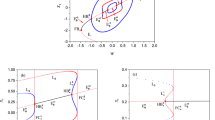Abstract
A parasystole from a heart-transplant patient is analysed using a beat-to-beat RR interval time series obtained from an electrocardiogram (ECG). The dysrhythmia, resulting from the co-existence of two pacemakers, the sinus node and an ectopic focus, presents distinctive regular patterns, with transitions from one pattern to another occurring abruptly. It is shown that the parasystolic rhythm can be simulated by a model involving two oscillators firing at fixed rates, under the restriction that neither is allowed to fire during the other's refractory period. It is found that the structure of the generated RR time series is essentially determined by the ratio of the periods of the two oscillators. In the case of a heart-transplant patient with a small heart-rate variability as a result of heart denervation, the model predicts the RR intervals with an error of less than 6% for an 80-beat sequence. From a physiological point of view, the results imply that the interaction between the two pacemakers in the heart is fairly weak, and hence the parasystole observed in the heart-transplant patient can be modelled as pure parasystole.
Similar content being viewed by others
References
Castellanos, A., Saoudi, N., Moleiro, F., andMyerburg, R. J. (1995): ‘Parasystole’,in Zipes, D., andJalife, J. (Eds.), ‘Cardiac electrophysiology: from cell to bedside’ (W. B. Saunders Company, Philadelphia) pp. 942–945
Fleming, G. B. (1912): ‘Triple rhythm of the heart due to ventricular extra-systole’,Q. J. Med.,5, pp. 318–326
Glass, L., Goldberger, A., andBelair, J. (1986): ‘Dynamics of pure parasystole’,Am. J. Physiol.,251, pp. H841-H847
Hoshino, K., Ikeda, N., Tanakadate, A., andMiyahara, H. (1989): ‘A computer-based model of parasystolic activity modulated by ventricular activation in the open-chest dog’,J. Electrocardiol.,22, pp. 277–283
Ikeda, N., Yoshizawa, S., andSato, T. (1983): ‘Difference equation model of ventricular parasystole as an interaction between cardiac pacemakers based on the phase response curve’,J. Theor. Biol.,103, pp. 439–465
Jalife, J., Antzelevich, C., andMoe, G. K. (1982): ‘The case for modulated parasystole’,Pace,5, pp. 911–926
Jalife, J., andMichaels, D. C. (1985): ‘Phase-dependent interactions of cardiac pacemakers as mechanisms of control and synchronization in the heart’,in Zipes, D. P., andJalife, J. (Eds.): ‘Cardiac electrophysiology and arrhythmias’ (Grune & Stratton, Orlando, Florida) pp. 109–119
Kaufmann, R., andRothberger, C. J. (1917): ‘Beitrag zur Kenntnis der Enstehungsweise Extrasystolischer Allorhythmien’,Z. Gesamte Exp. Med.,5, pp. 349–370
Moe, G. K., Jalife, J., Mueller, W. J., andMoe, B. (1977): ‘A mathematical model of parasystole and its application to clinical arrhythmias’,Circulation,56, pp. 968–979
Paola, R. D., Wang, H.-X., andNorwood, W. I. (1993): ‘Fractal structure underlying patterns of premature heart beats,’Am. J. Physiol.,265, pp. H1603-H1613
Robles deMedina, E. O., Delmar, M., Sicourik, S., andJalife, J. (1989): ‘Modulated parasystole as a mechanism of ventricular ectopic activity leading to ventricular fibrillation’,Am. J. Cardiol.,63, pp. 1326–1332
Saoudi, N., Letac, B., andCastellanos, A. (1995): ‘An electronic model for evaluating the dynamics of perfect pure parasystole in the human heart’,Am. J. Cardiol.,75, pp. 739–742
Author information
Authors and Affiliations
Corresponding author
Rights and permissions
About this article
Cite this article
Costa, M., Pimentel, I.R., Santiago, T. et al. Modelling a parasystolic rhythm in a heart-transplant patient. Med. Biol. Eng. Comput. 37, 492–496 (1999). https://doi.org/10.1007/BF02513335
Received:
Accepted:
Issue Date:
DOI: https://doi.org/10.1007/BF02513335




